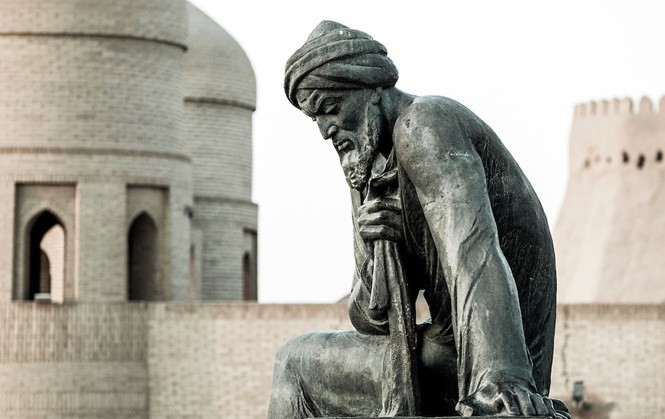Abu Abdullah Muhammed Al-Khorezmi (780–850): He is from Khwarezm (Uzbekistan). He worked in Baghdad. He systematized and named algebra. He contributed to the global understanding of geometry in the Arab and Western world. He advocated the necessity of the decimal system. He gave his name to the algorithm. Kutrubbul (?) 780 of Baghdad, Baghdad 813-850. Astronomer and prominent Muslim mathematician. The person who recites Indian numerals. Transoxiana Khiva, Uzbekistan. Mathematics, Astronomy. He came from Khwarezm and lived in Baghdad. He systematized algebra and gave it its name, made great contributions to the understanding of geometry, advocated the step system, and collected data on the location of 2,402 points on Earth.
TIME
“In fact, it is the human need to calculate that reflects everything. I discovered that everything contains numbers, and I discovered that number is nothing more than combining units. All numbers are expressed together for these reasons. However, I discovered that all numbers are arranged by deriving numbers up to ten. “
Harezmi (780-850)
GROUND
“I begin with the name of Allah who is the forgiving and forgiving, and I declare that the book called El-Kitâb el-Muhtasar fi Hisâb al-Jabr ve al-Muqâbele was published by Muhammad ibn-Musâ al-Khwarizmi. Muhammad says; Thanks be to Allah, who gave us the power to discover important numbers. In fact, it is the human need to calculate that reflects everything. I discovered that everything contains numbers, and I discovered that the number is nothing more than combining units. Therefore, all numbers are expressed together. However, I discovered that all numbers are arranged by the derivation of numbers up to ten. The number ten is evaluated together in the same way and is therefore calculated in the same way twice or three times as in the case of unity. So twice as 10 becomes 20, and three times it becomes 30. And in this way, you can reach 100 by 10 times. Again, just like 10, two and three times of 100 can be taken in this way. The number can be enlarged up to thousand with two times, three times etc. In this way, the investigation of the infinite number is made by taking the multiples of the thousand and naming the numbers in various ways.
Harezmi (780-850)
MIND
“In addition, the simplification and crossing over that I found occurs between three types. These; called roots, squares, and numbers. However, the numbers are neither linked only by roots nor by their squares. Of these, a root consists of units of a number that can be multiplied by itself. The square is the result of multiplying the root with itself. Two of these three forms can be equal to another, for example;
Squares equalization to roots,
Squares equal numbers,
Equating roots to numbers “Harezmi (780-850)
“A scientist either writes a work on a subject that no one has determined before him, or explains the subjects left closed by the scientists before him, makes it easier and understandable, or removes the deficiencies in the previously written works, corrects the mistakes”
“Thanks to God who empowered the discovery of important numbers.”
Harezmi (780-850)
DISCOVERY AND HAREZM OF ZERO
The inventor of zero is HAREZMİ. We are among the firsts starting with HAREZMİ and continuing with MATURİDİ. Our line of belief in the mind / mind in belief, which started with Harezmi, has gained continuity with Maturidi.
Our earliest thinker is Musa El Harezmi (780-850). Khorasan-Istanbul is an ancient line. The meanings of Hagia Sophia (Istanbul) and Kutadgu Bilig (Khorasan) are the same; SACRED KNOWLEDGE. The line that Alexander the Great headed with in 334 BC with the Asian Expedition is a multicultural line; Alexander went from that line to India. There is a meridian 0 (Hagia Sophia, Istanbul) and zero (Harezmi, Khorasan) on that line.
1000 years after Alexander the Great, this time the same line started to be active in the opposite direction, and information flow began to Baghdad, Istanbul and Europe via Khorasan. During the Khwarezmi period, Baghdad had become the center of philosophical intellectual studies uniting the West and East, India and the Mediterranean.
The statement of the late Erbakan, “If we ask the West for the patent of Zero, they cannot pay their debts if they give us 10 New York, 15 Paris, 20 London” is actually enough to explain the issue of zero and its importance.
With his work titled El-Cebr ve’l-Muqabele, which was systematically written for the first time on algebra, Harezmî revived the primitive algebra, basing all its solutions with geometric thoughts and put it into a systematic form.
‘Zero’ means ‘absence’ is an expression of something that is actually not. It is necessary to take an action for the zero to emerge. When we subtract one from one, it remains zero. In other words, an operation is absolutely necessary for zero. Let’s say we subtract one gold from one gold; the result is zero. So what happened to those gold coins? They stop, nothing happened to them. However, a zero emerged, or rather, “nothing” emerged. A “zero”, that is, “non-content” number emerged.
It was impossible to do mathematics with Latin numerals (originating from letters). Al-Khwarizmi is the father of all modern mathematics as the person who finds “zero”. He is the one who discovered the science of algebra. The logarithm exists with it today. As with other mathematical sciences. To whom do we owe the number of zeroes that I often come across in our money, exam notes or the codes of our computer (We know that computers use the binary system. That is to say, only 1 and 0 .. So if it were not zero, it would be almost impossible to use an object called a computer today)? Pay attention to these words:
“When eight leave the other eight, nothing remains.
Put a circle so it doesn’t stay empty! ”
That’s what Harezmi says; In his second work, which tells about Indian account and has been translated into Latin .. So Kitab al-Concise elephant Hisap al Hind ‘de. The use of the number system from 1 to 9 and the number zero in Europe is after the translation of Khwarezmî’s work into European languages. Until this date, the numeral system called Roman numerals was used in Europe, and it was impossible to develop mathematics with them.
It is worth noting that the Indians felt the presence of zero for the first time and they used spaces instead of zero when writing numbers. This is not at all practical. But what gives him a symbol and identity and in his work
“It is possible to do all operations with 9 numbers and this new symbol”
The concept of zero and HAREZMI
Harezmi is the true explorer of zero. So he is the man who completes the decimal system by adding zero to other numbers. Thus, the zero, which the Indians call sunya, attained its true identity with aerospace, which means hollow in the Islamic scientific world, and started its journey to Europe. The Germans called it ziffer and the French called it chiffre. There is something very interesting about the French name of zero alone. Chiffre also means password.
Do you think the French, feeling the magnificent power of zero, think what the password hidden in it is? Harezmî, for the first time, first and second degree equations with analytical method; He determined the rules and methods of solving equations with one unknown using algebraic and geometrical methods. Harezmî, who used the number zero in mathematics for the first time, introduced the science of algebra methodically and systematically. He systematized the topics of algebra before him under the name of “algebra” for the first time.
The first act of mathematics is counting… When the number system started to form, people knew only 1 and 2 for a very long time. Finding zero is much later. Humanity has lived without zero for centuries.
The Indians were the first to find it.
Harezmi is the first person who introduced this concept to the Islamic world and used it to calculate. In the first part of the Algebra Book devoted to the “Definition of Decimal Numbers”, Harezmi said:
When I thought, “What do people usually expect from calculation ?, I saw that the expected number is always.”
And “Kitâbu’l-Hisâbi’l-Hind” started to be written. The work was about operations such as addition, subtraction, multiplication and division, which we call four operations in arithmetic today. Indian numerals and the decimal number system entered the Islamic world with this work. Like the Algebra book, this work became the main source of all arithmetic books until the middle of the Western Renaissance.
Thanks to these two important mathematical works of Harezmi, the Indian numeral and calculus system, which was perfected by the Harezmi, began to replace the letter-number and calculus system, which has been in force in the West since the Romans.
Realizing that all numbers can be written with nine Indian numerals and a zero sign, while translating Harezmi’s book into Latin, Italian mathematician Fibonacci started the “Book of Abacus” with the following sentence, which would seem quite strange and incomprehensible for Europe:
“All numbers can be written with nine Indian numbers and a zero sign.”
And humanity is learning to count. Thanks to Harezmî, who systematically explained the number system and the art of calculus.
He worked on the basis of algebra in the field of mathematics. He found the basis of the binary number system and zero (0), which is the basis of today’s electronics. The word algebra comes from “El-Kitab`ül-Concise Hisab`il Algebra and Reaction” (book on algebra and equation).
His studies in mathematics form the basis of algebra. It was also determined that he used the digit number system instead of letters and syllables to express numbers for a period. The book of Calculus Algebra wal-Reaction is the first book in the field of mathematics in which systematic solutions of equations with first and second order unknowns are included. For this reason, Harezmi is known as the father of algebra.
Harezmi, who used zero for the first time in mathematics, is considered the founder of today’s algebra and trigonometry. He found ways to solve first and second order equations by analytical method and equations with one unknowns by algebraic and geometric methods.
“The number zero was banned in Europe for a long time as the invention of Muslim Turks and was excommunicated by the church. Both Kabbalists and Pythagoras explained the value of everything in the universe in numbers, but they could not calculate the value of something.
That thing they could not calculate was actually not “something”. Absence! How would something be marked? This figure was gifted to the world by an Uzbek Turk (780-850) who can be described as the greatest scientist in the history of mathematics:
“When eight leave the other eight, nothing remains. Put a circle so it doesn’t stay empty! ”





















